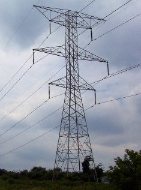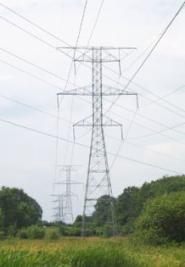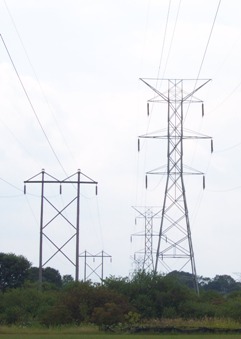 Within the past thirty years there has been a concern that exposure to electro-magnetic fields (or more accurately, electric magnetic fields, a.k.a. EMFs) can cause health problems in humans, especially cancer-related illnesses. This concern has been fueled by early research indicating a possible link between EMFs from high power lines and childhood leukemia (Wertheimer, 1979). This study, among others, was made available to the public and has since been a topic of concern amongst the public, as indicated by a public opinion poll that listed EMFs as the "number one environmental concern" (USA Today, public survey, 1996). Electric transmission lines have been cited as a source of EMFs and, hence, a concern of the public.
Within the past thirty years there has been a concern that exposure to electro-magnetic fields (or more accurately, electric magnetic fields, a.k.a. EMFs) can cause health problems in humans, especially cancer-related illnesses. This concern has been fueled by early research indicating a possible link between EMFs from high power lines and childhood leukemia (Wertheimer, 1979). This study, among others, was made available to the public and has since been a topic of concern amongst the public, as indicated by a public opinion poll that listed EMFs as the "number one environmental concern" (USA Today, public survey, 1996). Electric transmission lines have been cited as a source of EMFs and, hence, a concern of the public.
Electric power transmission lines are the electric lines that transport electricity from one distribution point to another. These lines are typically high voltage, 65kv (kilovolts) or higher. They are often suspended along tall towers made of metal (common) or wood (less common). These lines are not to be confused with the distribution lines which bring the electric power to the electric company's customers. Those lines are of less voltage and considered by most to be relatively harmless in relation to the EMF issue. That, of course, is a perception that can be scientifically challenged, but, nonetheless it's a perception of the public.
Valuation of electric power transmission line easements must take into consideration two factors: (1) the effects such a line has on the land the easement covers; and, (2) the effects the presence of such a line and corresponding easement has on the surrounding property.

 In valuing the easement land the appraiser must consider all the limitations specified in the easement as to use. These limitations can have an effect on the property value of the easement itself. The effect can diminish the land value from a fraction, say 25%, to rendering the entire parcel of no value to the land owner. Additionally, the easement document must be reviewed and the analysis must take into consideration all the uses allowed by the easement, regardless of the present use. An example of this would be an easement for any electric power line with a present use being a 65kv line. The valuation must take into consideration the "any" use aspect meaning, though the current line may be 65kv, the utility company holds the right to upgrade that line size anytime they desire without further compensation. This would allow the line to be upgraded to, say a 765kv line with the corresponding high towers. Additionally, more and more of these easements are being written in a manner that allows other utility use such as cable, cell phone relay, and sometimes even gas pipelines. These easements often allow the land owner to transverse the easement area for their private purposes, but limit the use and improvements in the easement area. Improvements are rarely allowed. Keep in mind the easement holder has the right to their easement for any purpose, and with that right comes the right to remove or destroy any such "non-allowable" improvements that may impede their access.
In valuing the easement land the appraiser must consider all the limitations specified in the easement as to use. These limitations can have an effect on the property value of the easement itself. The effect can diminish the land value from a fraction, say 25%, to rendering the entire parcel of no value to the land owner. Additionally, the easement document must be reviewed and the analysis must take into consideration all the uses allowed by the easement, regardless of the present use. An example of this would be an easement for any electric power line with a present use being a 65kv line. The valuation must take into consideration the "any" use aspect meaning, though the current line may be 65kv, the utility company holds the right to upgrade that line size anytime they desire without further compensation. This would allow the line to be upgraded to, say a 765kv line with the corresponding high towers. Additionally, more and more of these easements are being written in a manner that allows other utility use such as cable, cell phone relay, and sometimes even gas pipelines. These easements often allow the land owner to transverse the easement area for their private purposes, but limit the use and improvements in the easement area. Improvements are rarely allowed. Keep in mind the easement holder has the right to their easement for any purpose, and with that right comes the right to remove or destroy any such "non-allowable" improvements that may impede their access.
 In valuing the effects of such a line to the surrounding properties one must consider the "fear factor" that was cited earlier. Most of the public does believe that these high power lines are not healthy. In addition, the presence of the lines, if observable, is a visual detraction. These health, safety and un-appealing view concerns often translate into a devaluation of property value.
In valuing the effects of such a line to the surrounding properties one must consider the "fear factor" that was cited earlier. Most of the public does believe that these high power lines are not healthy. In addition, the presence of the lines, if observable, is a visual detraction. These health, safety and un-appealing view concerns often translate into a devaluation of property value.
Several studies have been completed on this issue with mixed results. Our own study, which surveyed the effects that such power lines and their corresponding easements have on residential property values, indicated a definite devaluation effect. Of course, the amount of diminished value is dependent on a number of factors not limited to the size of the line, size of the easement, height of the towers, whether the lines are readily observable, etc. Only an onsite inspection of the property in question and a studied review of the easement documentation can adequately determine the total effects that such an easement will have on a property.
Please contact us if you are interested in learning more about this type of easement and its effect on property value, or explore a brief review of EMFs and links to EMF literature.